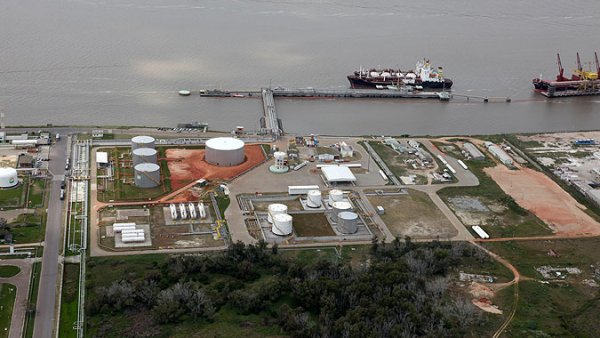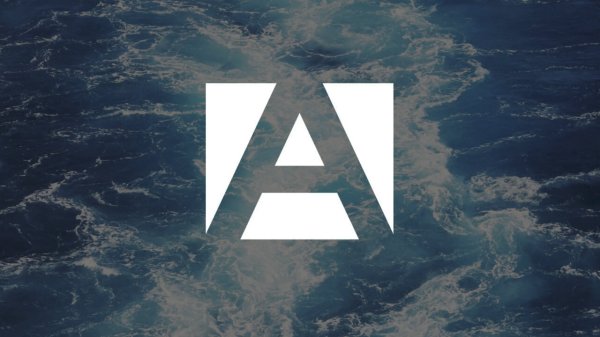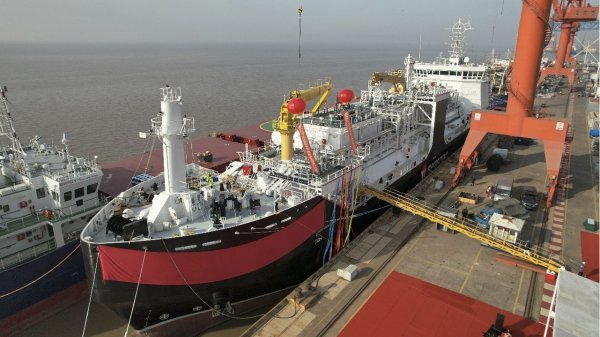Dual-fuel-capable COGES system for new LNG carrier
Dual-fuel gas turbine system can operate either on the carrier's cargo of boil-off gas or on marine gas oil (MGO).
Hudong-Zhonghua Shipbuilding (Group) Co., Ltd. (HZ) and GE's Marine Solutions have received approval in principle (AIP) from the America Bureau of Shipping (ABS) for a jointly developed liquefied natural gas (LNG) carrier design to be powered by GE's Combined Gas Turbine Electric and Steam (COGES) system.
"We are delighted to work with Hudong-Zhonghua Shipbuilding on this 178,000 cubic-metre LNG carrier design that will use our efficient, reliable and dual-fuel marine gas turbine," said GE's Brien Bolsinger, Vice President, Marine Operations. "With AIP in hand from ABS, customers can now procure this LNG carrier that is capable of meeting Tier III International Maritime Organization and Tier 4 United States Environmental Protection Agency emissions requirements today," Bolsinger added.
"Thanks to the compact and lightweight attributes of GE's COGES arrangement, customers can realize an additional 4,000 cubic metres of LNG cargo space versus a traditional 174,000-cubic-metre LNG carrier powered by dual-fuel diesel engines," said HZ President Chen Jun. "Also, since the GE gas turbine is dual-fuel capable, it can operate either on the carrier's cargo of boil-off gas or on marine gas oil (MGO) to provide for all power and propulsion."
"New technologies and innovations are essential ingredients for sustainable growth of the marine industry and protection of our natural environment," said Bill Shi, ABS Vice President of Engineering, Greater China Division. "By evaluating this new design concept jointly developed by Hudong-Zhonghua and GE and granting this milestone AIP, we have acknowledged that the eco-friendly propulsion system is in compliance in principle with the requirements of the ABS standards and international regulations. We are pleased to be an integral part of this joint development project with a great potential to reduce exhaust emissions."
The COGES system will feature one GE LM2500-family gas turbine generator, one heat recovery steam generator (HRSG) and one steam turbine generator. Additional specifications for the HZ LNG carrier are in Table 1.
The LM2500-family gas turbine used in GE's COGES system is derived from GE's CF6 aircraft engines. In fact, the marine gas turbine maintains a high degree of commonality with its flight-tested forerunner, boasting the same field reliability of 99.9%.
Hudong-Zhonghua Shipbuilding COGES-powered LNG carrier specifications
- Cargo tank capacity (100%) -- 178,000 m3
- Length overall -- ~ 290.00m
- Length between perpendiculars -- 284.00
- Breadth (MLD) -- 46.95m
- Depth at side at main deck (MLD) -- 26.25m
- Depth at side at trunk deck (MLD) -- 33.40m
- Design Draught (MLD) -- 11.5m
- Scantling draught (MLD) -- 12.5m
- Deadweight (at design draught) -- ~ 83,500t
Gas turbine benefits
The compact COGES arrangement - fully 80 percent lighter and 30 percent smaller than comparable two-stroke diesels - will allow for increased container carrying capability. The COGES system also offers customers lower life cycle costs, negligible lubricating oil consumption, no methane slip and no pilot fuel or exhaust treatment required, according to GE.
Maintenance is said to be "easy" since little is required with COGES, only about 300 man-hours per year while the ship is underway. When more extensive maintenance is required, the entire turbine can be removed and replaced within 24 hours, reducing downtime and enabling maintenance to be carried out with minimal interruption to ship operations.
"We are delighted to work with Hudong-Zhonghua Shipbuilding on this 178,000 cubic-metre LNG carrier design that will use our efficient, reliable and dual-fuel marine gas turbine," said GE's Brien Bolsinger, Vice President, Marine Operations. "With AIP in hand from ABS, customers can now procure this LNG carrier that is capable of meeting Tier III International Maritime Organization and Tier 4 United States Environmental Protection Agency emissions requirements today," Bolsinger added.
"Thanks to the compact and lightweight attributes of GE's COGES arrangement, customers can realize an additional 4,000 cubic metres of LNG cargo space versus a traditional 174,000-cubic-metre LNG carrier powered by dual-fuel diesel engines," said HZ President Chen Jun. "Also, since the GE gas turbine is dual-fuel capable, it can operate either on the carrier's cargo of boil-off gas or on marine gas oil (MGO) to provide for all power and propulsion."
"New technologies and innovations are essential ingredients for sustainable growth of the marine industry and protection of our natural environment," said Bill Shi, ABS Vice President of Engineering, Greater China Division. "By evaluating this new design concept jointly developed by Hudong-Zhonghua and GE and granting this milestone AIP, we have acknowledged that the eco-friendly propulsion system is in compliance in principle with the requirements of the ABS standards and international regulations. We are pleased to be an integral part of this joint development project with a great potential to reduce exhaust emissions."
The COGES system will feature one GE LM2500-family gas turbine generator, one heat recovery steam generator (HRSG) and one steam turbine generator. Additional specifications for the HZ LNG carrier are in Table 1.
The LM2500-family gas turbine used in GE's COGES system is derived from GE's CF6 aircraft engines. In fact, the marine gas turbine maintains a high degree of commonality with its flight-tested forerunner, boasting the same field reliability of 99.9%.
Hudong-Zhonghua Shipbuilding COGES-powered LNG carrier specifications
- Cargo tank capacity (100%) -- 178,000 m3
- Length overall -- ~ 290.00m
- Length between perpendiculars -- 284.00
- Breadth (MLD) -- 46.95m
- Depth at side at main deck (MLD) -- 26.25m
- Depth at side at trunk deck (MLD) -- 33.40m
- Design Draught (MLD) -- 11.5m
- Scantling draught (MLD) -- 12.5m
- Deadweight (at design draught) -- ~ 83,500t
Gas turbine benefits
The compact COGES arrangement - fully 80 percent lighter and 30 percent smaller than comparable two-stroke diesels - will allow for increased container carrying capability. The COGES system also offers customers lower life cycle costs, negligible lubricating oil consumption, no methane slip and no pilot fuel or exhaust treatment required, according to GE.
Maintenance is said to be "easy" since little is required with COGES, only about 300 man-hours per year while the ship is underway. When more extensive maintenance is required, the entire turbine can be removed and replaced within 24 hours, reducing downtime and enabling maintenance to be carried out with minimal interruption to ship operations.

|
IMO approves pricing mechanism based on GHG intensity thresholds
Charges to be levied on ships that do not meet yearly GHG fuel intensity reduction targets. |
|
|
|
||

|
VARO Energy expands renewable portfolio with Preem acquisition
All-cash transaction expected to complete in the latter half of 2025. |
|
|
|
||

|
NYK trials biofuel in milestone coal carrier test
Vessel is used to test biofuel for domestic utility company. |
|
|
|
||

|
H-Line Shipping orders LNG bunkering vessel
Vessel with 18,000-cbm capacity to run on both LNG and MDO. |
|
|
|
||

|
How to engineer and manage green shipping fuels | Stanley George, VPS
Effective management strategies and insights for evolving fuel use. |
|
|
|
||

|
Swedish government bans scrubber wastewater discharges
Discharges from open-loop scrubbers to be prohibited in Swedish waters from July 2025. |
|
|
|
||

|
MAN Energy Solutions achieves 100% load milestone for ammonia engine
Latest tests validate fuel injection system throughout the entire load curve. |
|
|
|
||

|
Petrobras secures ISCC EU RED certification for B24 biofuel blend at Rio Grande
Blend consisting of 24% FAME is said to have been rigorously tested to meet international standards. |
|
|
|
||

|
Stolt-Nielsen to fully control Avenir LNG with acquisition
Share purchase agreement to buy all shares from Golar LNG and Aequitas. |
|
|
|
||

|
Bureau Veritas supports launch of CIMC SOE's LNG bunkering vessel
Handover of Seaspan Energy's cutting-edge 7,600-cbm vessel completed. |
|
|
|
||
Related Links
- · Concept design for LNG bunkering vessel released [Insights]
- · Demonstration of dual-fuel engine for LNG carriers [Insights]
- · Wartsila develops inert gas solution for 17 LNG carriers [Insights]
- · Boil-off gas monitoring system launched [Insights]
- · Sener designs LNG bunkering vessel [Insights]

